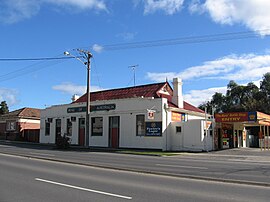Long Gully
| Long Gully Bendigo, Victoria | |
|---|---|
 Rose of Australia Hotel | |
 | |
| Coordinates | 36°44′S 144°15′E / 36.733°S 144.250°E |
| Population | 3,383 (2016 census)[1] |
| Postcode(s) | 3550 |
| Location | 3 km (2 mi) NW of Bendigo |
| LGA(s) | City of Greater Bendigo |
| State electorate(s) | Bendigo West |
| Federal division(s) | Bendigo |
Long Gully is a suburb of Bendigo in Victoria, Australia. It is located 3 kilometres (1.9 mi) north-west of the Bendigo central business district. At the 2016 census, Long Gully had a population of 3,383.[1]
Long Gully is a working-class suburb of Bendigo, with many older style fibro houses, punctuated by well-established light industry. The suburb is the location of the Bendigo RSL club, in Havilah Road.
History
[edit]Long Gully was home to the Carlisle United Gold Mine (formerly the Kentish Mine), which was the richest mine in Bendigo, producing 21.5 tonnes of gold in its lifetime.[2]
Long Gully was heavily affected by the Black Saturday bushfires on 7 February 2009, causing one death.[3]
Amenities
[edit]Schools and churches
[edit]Long Gully Primary School (No. 2120) was built in 1879. When it closed in 1992, a majority of the students were transferred to Comet Hill Primary School.[2]
Long Gully had several churches built throughout its history. A uniting church (originally a Methodist church) was built in 1877. In 1883, St Matthew's Anglican Church was built. A third church, the Church of Pius X, was built in 1956, and is now privately owned.[2]
Fire stations
[edit]In 1873, the Long Gully Fire Brigade was formed. It operated from a fire station until a second fire station was opened in 1932; the first station was deregistered the same year.[2]
Notable residents
[edit]It is the birthplace of Dick Richards, GC (14 November 1894 – 8 May 1986).[4] Richards was an Australian science teacher who joined Sir Ernest Shackleton's Imperial Trans-Antarctic Expedition in December 1914 as a physicist with the Ross Sea Party. He was 22 years old. He outlived all other members of the expedition and became the last survivor of the so-called "Heroic Age" of Antarctic exploration, dying at the age of 91 in 1986. His life-saving feats in the Antarctic are detailed in the book Shackleton's Heroes.
References
[edit]- ^ a b "2016 QuickStats Long Gully". Australian Bureau of Statistics. Retrieved 19 July 2018.
- ^ a b c d Arnold, Jean; Arnold, Ken (2007). Out & About: Eaglehawk to Bendigo CBD. Bendigo, Victoria: Crown Castleton Publishers. p. 23-25. ISBN 9781875342709.
- ^ "Victoria under siege as fires rage across state". Herald Sun. 8 February 2009. Archived from the original on 8 February 2009. Retrieved 8 February 2009.
- ^ McOrist, Wilson Shackleton's Heroes The Robson Press, London, 2015 ISBN 978-1-84954-815-1


 French
French Deutsch
Deutsch